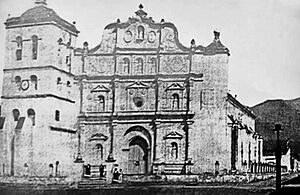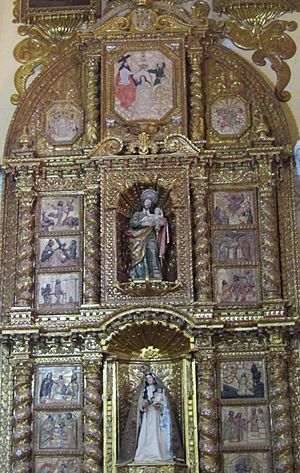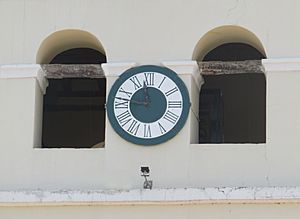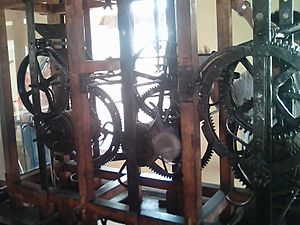Immaculate Conception Cathedral, Comayagua facts for kids
Quick facts for kids Immaculate Conception Cathedral |
|
|---|---|
| Catedral de Comayagua | |
|
Catedral de la inmaculada concepción
|
|
 |
|
| Location | Comayagua |
| Country | Honduras |
| Denomination | Roman Catholic Church |
| Architecture | |
| Style | Baroque |
| Years built | • 1563, first stage • 1611–1634, second stage • 1705–1711, last stage |
The Immaculate Conception Cathedral, also known as the Comayagua Cathedral, is a very old and beautiful church in Comayagua, Honduras. It's dedicated to the Virgin Mary and stands proudly in the city's main square. This cathedral is one of the oldest in Central America. It was built in different stages, starting in the 1500s and finally opening on December 8, 1711. It has been changed and updated many times since then.
Contents
History of the Cathedral
The Comayagua Cathedral has a history stretching back over 400 years. It's a bit tricky to know all the details because many old historical documents, like building plans or drawings, are missing. However, thanks to special studies and digging inside the building, we're learning more about its past. We now understand better how it changed and was rebuilt over the centuries.
Building in Colonial Times
Back in the 1600s, the city of Comayagua didn't have a very big church. The main one was the Iglesia de la Merced. So, in 1563, people asked for permission to build a larger church that could serve as another cathedral for the town. This is how the construction of the current cathedral began.
According to historical notes, this first cathedral was damaged around 1610. Heavy rainstorms likely caused parts of the building to collapse. So, in 1611, the authorities decided to rebuild it. Important people like Bishop Alonso Vargas y Abarca, Bishop Fray Juan Pérez Carpintero, and Bishop Fray Antonio López de Guadalupe helped oversee the work. Many parts of the church, like its decorations, were brought all the way from Jaén, Spain. Records show that about 18 groups of indigenous people worked hard to build this important Catholic monument.
The final big building phase happened in the 1700s. By 1703, the bishop wrote to King Felipe V that the second version of the cathedral was already showing signs of wear and tear. The walls were in poor condition, so in 1705, the third and final stage of construction began. During this time, the front of the cathedral was changed to look like it does today. The cathedral was officially blessed in 1715.
The Cathedral in Modern Times

In the 1700s, this church was the biggest building in the region of Honduras. Later, on December 30, 1825, it was the wedding place for General Francisco Morazán, a very important historical figure. However, on April 4, 1827, Comayagua was attacked and looted during a civil war. The cathedral was damaged and robbed during this time.
In the mid-1800s, a bishop named Juan Felipe Zepeda took charge. He used money from church offerings to pay musicians for the cathedral. He also used money he inherited from his father to improve the cathedral. He even bought a new organ from London to donate to the church.
For many centuries, people were buried inside the church. According to a local historian, the bodies of two bishops, Don Juan Merlo de la Fuente and Fray Gaspar de Andrade, were once displayed in glass cases in the 1960s because they were very well preserved. But in 1963, another bishop ordered them to be hidden, and they haven't been shown since.
The cathedral is built with brick and adobe walls and has a tile roof. It has 10 windows that let light into the inside. The building has five main sections supported by ten large pillars that form arches. The cathedral was dedicated to Santa María, Jesus' mother, and is located in the city's Central Plaza. In the early 2000s, the cathedral was fully restored. This project helped bring the historic center of Comayagua back to life. Today, the cathedral is still a very important place for the people of Comayagua. It's one of the city's most treasured historical sites, along with other old churches like La Merced, San Francisco, San Sebastián, and La Caridad.
Cathedral Architecture
Inside the Cathedral

The inside of the cathedral is shaped like a Latin cross. It has three main aisles with rounded ceilings. The area around the main altar has three dome-shaped ceilings. There's also an extra room where the chapel of the Blessed Sacrament is located.
At the main altar, you can see a beautiful wooden altarpiece covered in gold. It features a carving of the Immaculate Conception and a crucifix. These were made in 1620 by a Spanish artist named Francisco de Ocampo and given to the city by King Felipe II of Spain.
It's believed that the cathedral originally had 16 altarpieces or altars. Today, it has four large altars. These are decorated with finely carved wood and covered with gold leaf. Some also have beautiful paintings or images. Eight religious images found throughout the church were donated by King Felipe VI of Spain. The crucified figure, also made by Francisco de Ocampo from Jaén, was donated in 1620.
During recent restoration work, builders found the remains of the original cathedral Choir. This choir was built in the 1700s and taken down in the 1930s. They found its foundations, showing that the entrance to the choir was in front of the main altar. Its steps had a special three-lobed shape, similar to the steps of the main altar area.
The pulpit inside the cathedral was built around the same time as the altarpieces. It's in the fancy Baroque style. The lamps hanging from the ceiling today are copies of the original silver lamps. The real silver lamps are now on display in the colonial museum in Comayagua. The church also has an organ that arrived in the city on December 7, 1887. It was first played in the cathedral then. The organ isn't used very often now, only for special occasions like Holy Week, Christmas, or weddings.
Outside the Cathedral
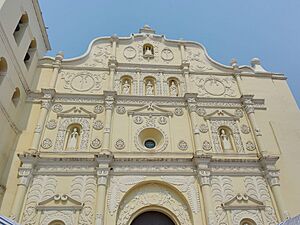
The outside of the cathedral has a mix of Renaissance and Baroque styles. The front looks like a large altarpiece with three sections. The middle section is wider and has the main entrance, which is a rounded arch door. The sections are separated by columns and horizontal ledges, creating four levels.
In the niches (small alcoves) on the front, you can see statues of four important Church scholars. In the central section, on the third level, there are statues of the Virgin Mary, with Saint John the Baptist and Saint Joseph on either side. The garden on the left side of the cathedral has changed over time. It was originally a cemetery for religious officials like bishops. However, it was closed in the 1800s to become a garden. This happened because a law in March 1843 stopped churches from using their patios for burials. Finally, on the fourth level of the façade, there is a figure of Christ giving a blessing.
The tall bell tower on the left side of the main front is very noticeable. It has four stories, and the top one holds the eight bells. This bell tower was finished after the main front. It has a colorful, glazed ceramic dome on top.
The Ancient Clock
Inside the cathedral's tower, you'll find the oldest working clock in the Americas. It was built by the Arabs in Spain around the year 1100, during the Middle Ages. Before it came to the Americas, it was located in the Alhambra, a famous Arab palace in Granada, Spain.
King Felipe III of Spain ordered the clock to be moved to the Hibueras region of New Spain (which is now Honduras). There, it would serve as the city's public clock. The clock works using gears, ropes, weights, and a pendulum. The time is shown on a dial on the front of the church. You might notice that the Roman numeral for 4 is shown as IIII instead of IV. Before it was installed in the cathedral, this clock worked for a while in the La Merced church, which was the main cathedral before the Immaculate Conception Cathedral was finished in 1715.
In 2007, the clock was carefully restored. This work was done by the local government and cultural groups, with help from the Honduran Institute of Anthropology and History. A master clockmaker from Guatemala, Rodolfo Antonio Cerón Martínez, worked for five months to fix it. He finished his work on December 20, 2007.
There's a debate about whether this clock is the oldest in the world. Another clock in England claims to be older. However, the English clock is made of cast iron, while the Comayagua clock is made of wrought iron. Wrought iron is an older technique than cast iron, which suggests the Comayagua clock might indeed be the oldest.
See also
 In Spanish: Catedral de la Inmaculada Concepción (Comayagua) para niños
In Spanish: Catedral de la Inmaculada Concepción (Comayagua) para niños
- Roman Catholicism in Honduras
- Comayagua
- History of Honduras


